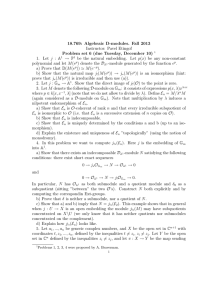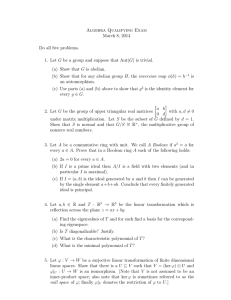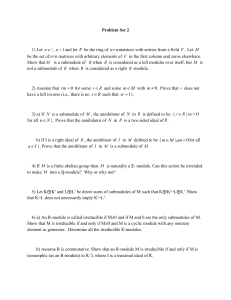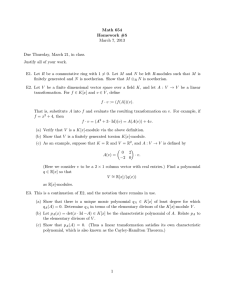Fully Dual-Stable Modules
advertisement
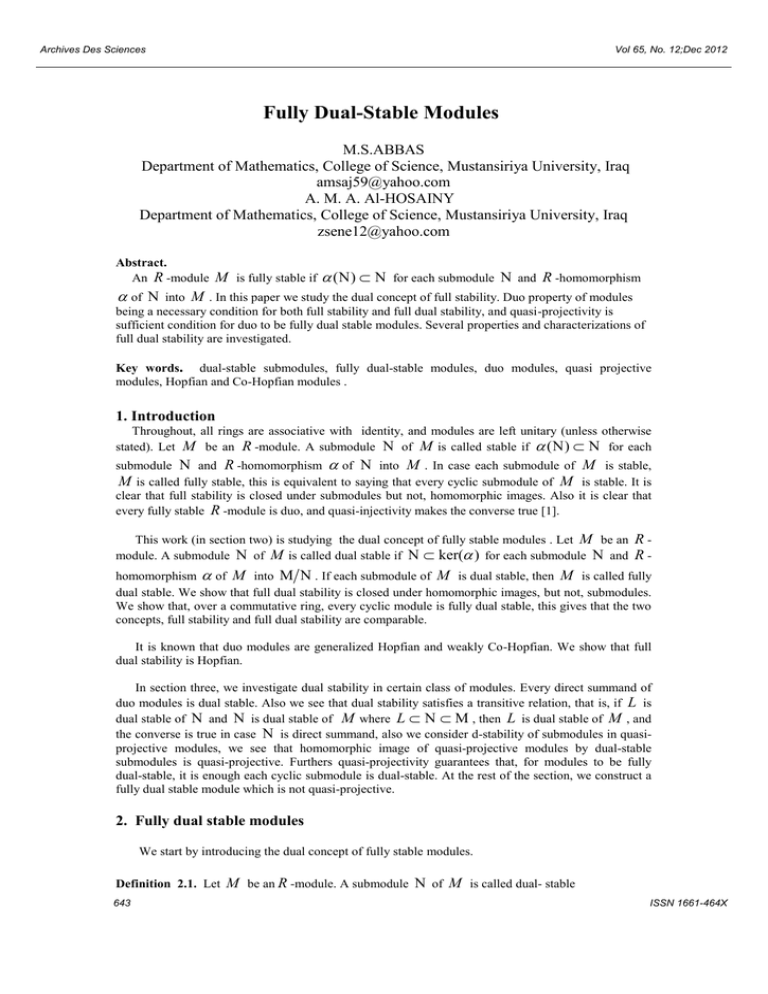
Archives Des Sciences
Vol 65, No. 12;Dec 2012
Fully Dual-Stable Modules
M.S.ABBAS
Department of Mathematics, College of Science, Mustansiriya University, Iraq
amsaj59@yahoo.com
A. M. A. Al-HOSAINY
Department of Mathematics, College of Science, Mustansiriya University, Iraq
zsene12@yahoo.com
Abstract.
An R -module
M is fully stable if ( ) for each submodule and R -homomorphism
of into M . In this paper we study the dual concept of full stability. Duo property of modules
being a necessary condition for both full stability and full dual stability, and quasi-projectivity is
sufficient condition for duo to be fully dual stable modules. Several properties and characterizations of
full dual stability are investigated.
Key words. dual-stable submodules, fully dual-stable modules, duo modules, quasi projective
modules, Hopfian and Co-Hopfian modules .
1. Introduction
Throughout, all rings are associative with identity, and modules are left unitary (unless otherwise
stated). Let M be an R -module. A submodule of M is called stable if ( ) for each
submodule and R -homomorphism of into M . In case each submodule of M is stable,
M is called fully stable, this is equivalent to saying that every cyclic submodule of M is stable. It is
clear that full stability is closed under submodules but not, homomorphic images. Also it is clear that
every fully stable R -module is duo, and quasi-injectivity makes the converse true [1].
This work (in section two) is studying the dual concept of fully stable modules . Let M be an
module. A submodule of M is called dual stable if ker( ) for each submodule and
RR-
homomorphism of M into . If each submodule of M is dual stable, then M is called fully
dual stable. We show that full dual stability is closed under homomorphic images, but not, submodules.
We show that, over a commutative ring, every cyclic module is fully dual stable, this gives that the two
concepts, full stability and full dual stability are comparable.
It is known that duo modules are generalized Hopfian and weakly Co-Hopfian. We show that full
dual stability is Hopfian.
In section three, we investigate dual stability in certain class of modules. Every direct summand of
duo modules is dual stable. Also we see that dual stability satisfies a transitive relation, that is, if L is
dual stable of and is dual stable of M where L , then L is dual stable of M , and
the converse is true in case is direct summand, also we consider d-stability of submodules in quasiprojective modules, we see that homomorphic image of quasi-projective modules by dual-stable
submodules is quasi-projective. Furthers quasi-projectivity guarantees that, for modules to be fully
dual-stable, it is enough each cyclic submodule is dual-stable. At the rest of the section, we construct a
fully dual stable module which is not quasi-projective.
2. Fully dual stable modules
We start by introducing the dual concept of fully stable modules.
Definition 2.1. Let
643
M be an R -module. A submodule of M is called dual- stable
ISSN 1661-464X
Archives Des Sciences
Vol 65, No. 12;Dec 2012
N Ker ( ) for each R -homomorphism : M M N . In case each
submodule of M is d-stable, M is called fully dual stable (simply, fully d-stable) . A ring R is fully
d-stable if it is a fully d-stable R -module.
(simply, d-stable) if
Examples and Remarks 2.2.
(a) It is clear that every simple R -module is fully d-stable.
(b) is fully d-stable -module. For, let f :
n be any -homomorphism and
f (n) nf (1) n x0 for some x0 , 0 x0 n 1 . Hence f (n) nx0 0 , so
n ker f implies that nZ ker f . However is not fully stable [1].
(c) Q is not fully d-stable Z -module since. Consider the - homomorphism , : Q Q Z
r
defined by ( r ) Z , Z ker f .
3
(d) It is well-known that the quotient of the Z -module Z ( p ) by every proper submodule is
isomorphic
to
Z ( p ) , thus if : Z ( p ) ( p ) ( p k ) is an isomorphism then
Z ( p k ) ker ., ( k 1 ).This shows that Z ( p ) is not fully d-stable, while it is a fully
stable module[1].
(e) From (b) and (d), it follows that the concepts of full stability and full d-stability are
completely independent, while Q is neither fully stable [1] nor fully d-stable and, from (a),
simple module are both fully stable and fully d- stable..
(f) Recall that an R - module is called duo if each submodule of is fully invariant ,that
is, f ( ) for each R -endomorphism f of and each submodule . For let be
R - module , and f be an R -endomorphism of , set
f : where : is the natural epimorphism of onto
a submodule of a fully d-stable
. Then ker f
1
( ) . This shows that duo property is a necessary condition
for full d-stability. Note that the converse of this statement may not be true generally, for
example the Z -module Z ( p ) is duo, but not fully d-stable.
(g) It is clear that a submodule of a fully stable R - module is fully stable, unlike for fully dstable ( see example (2.5 b)). On the other hand, homomorphic image of fully stable R module need not be fully stable [1]. However we shall see that full d-stability is closed under
every homomorphic image, and hence every direct summand of fully d-stable R - module is
fully d-stable.
Proof: Let be a submodule of a fully d-stable R - module and
: ( ) ( ) be an R -homomorphism ,where is a submodule of
containing . Put : where : is the natural
epimorphism of onto and : ( ) ( ) is an isomorphism.
1
Then ker (ker ) , that is ker .
R - module , if R has no zero divisors, then the torsion submodule T ( ) is dstable. If : M M T ( ) , and x ( ) , then there exists 0 r R such that
rx 0 , hence (rx ) 0 then r ( x) 0 . If ( x) y ( ) , then
ry ( ) 0 , that is , ry ( ) , then there exists 0 s R such that
s (ry ) 0 , hence ( sr ) y 0 with sr 0 (since R has no zero divisors) , that is,
y ( ) which means ( x) 0 .
(h) For any
644
ISSN 1661-464X
Archives Des Sciences
Vol 65, No. 12;Dec 2012
In the next we consider a sufficient conditions for a duo R -module to be fully d-stable. Note that a
sufficient condition for duo R -module to be fully stable is quasi-injectivity.[1]
R -module is quasi-projective if for each submodule of and each R of such that f
where : is the natural epimorphism.[2]
Proposition 2.3. Every fully invariant submodule of a quasi-projective R -module is
d-stable and hence every quasi-projective duo R -module is fully d-stable.
Recall that an
homomorphism
: M M N , there exists an R -endomorphism f
be a fully invariant submodule of a quasi-projective R -module ,
and : M M N be an R-homomorphism. Then there is an R -endomorphism f of such
Proof: Let
that
f
, but
f ( ) , so f
1
( ) ker . This shows that is d-stable.
We shall see later that fully d-stable modules may not be quasi-projective. Next, we give an
example to show that full d-stability is not closed under submodule. First, we need the following
corollary of the above proposition.
Corollary 2.4. Every commutative ring
R is fully d-stable.
This corollary and remark (2.2 g), imply that any cyclic module over a commutative ring is fully dstable. The following example shows that corollary (2.4) is not true for non commutative ring and
hence cyclic modules over a non commutative ring need not be fully d-stable.
Examples 2.5.
(a) Let
R be a commutative ring , S = 22 ( R) , the
a 0
a
,
b
R
2 2 matrices over R and
,then is a left
b o
a b a b 0 1
ideal of S . Define f : S S , defined by f (
)
, then f
c d c d 0 0
is an S -endomorphism , but f () , so S is not duo and hence not fully d-stable,
even though S is quasi-projective.
ring of all
, R , we define a multiplication on R by
( x, m) ( y, n) ( xy, xn ym) , by corollary (2.4), it is fully d-stable R module.
0 is a submodule of R which is not duo (so not fully d-stable) module. Note that If
R is a proper subring of a ring S , then the left R module S is not duo ([8], proposition
(b) Let
1.6) and hence not fully d-stable.
In the following, we discuss full d-stability of free modules. First of all the following corollary
discuss full d-stability of free modules of rank one, and the proof follows from remark (2.2 f) and
proposition (2.3).
Corollary 2.6. A ring
R is fully d-stable if and only if R is duo.
For free modules of rank more than one we have the following.
Proposition 2.7 . For any ring
stable.
645
R , any free R module with rank greater than one is not fully dISSN 1661-464X
Archives Des Sciences
Vol 65, No. 12;Dec 2012
Proof: Let
be a free R -module and be a basis for with 2 . For any
two distinct
x1 , x 2 of , we define an endomorphism f of as follows:
f ( x) x if x , and x xi , i 1,2 , f ( x1 ) x 2 , and f ( x 2 ) x1 .
Now if i is a submodule of generated by xi ( i 1,2 ) then f ( 1 ) 2 1 .
This shows that is not duo and hence not fully d-stable.
elements
It is well-known that any finitely generated torsion free module over a P. I. D. is free, (see [6], IV
6.5), so by proposition (2.7) , corollary (2.4) and remark (2.2 g), we have the following.
Corollary 2.8. A finitely generated torsion free module
only if it is isomorphic to R .
M over a P.I.D. R , is fully d-stable if and
We close this section by further properties of fully d-stable modules. First, recall a lemma and
certain concepts that appear in [8].
Lemma 2.9[8]. Let R be a ring . Then an R -module is duo if and only if for each R
endomorphism f of and each m in , there exists r in R such that f ( m) rm .
Definitions 2.10 [3]. Let be an R -module.
(a) is called Hopfian (Co- Hopfian) if every surjective (injective) endomorphism of is an
isomorphism.
(b) is called generalized Hopfian (weakly Co- Hopfian) if every surjective (injective)
endomorphism of has a small kernel (has an essential image).
It is known that duo modules are generalized Hopfian and weakly Co-Hopfian, but neither Hopfian
nor Co-Hopfian, we shall use lemma (2.9) to give a characterization of fully d-stable modules . First we
consider the following necessary condition.
be a fully d-stable R -module, a submodule of and :
any R -homomorphism. Then for each m there exists r in R such that ( m) rm
( r depends on and m ).
Theorem 2.11. Let
: , by (m ) (m) .Full d-stability of implies
that ker , so if m , then ( m) 0 , this shows that is well-defined and it is an easy
matter to check that is an R -homomorphism. By (1.2 f and g), is fully d-stable and hence
Proof:
Define
(m ) there is r in R such that
(m ) rm , and hence (m) rm .
duo. Lemma (2.9) implies that for each
It is clear that if
:
has the property that for each
m there exists r in R such
that ( m) rm , then ker . So we have the following characterization of full d-stability
.
Corollary 2.12. An R -module is fully d-stable if and only if for each submodule each R homomorphism
: has the property that for each m there exists r in R such that
(m) rm ( r depends on and m ).
Now, we modify lemma (2.9) with extra conditions to characterize duo modules in such a way that
the existence of the element r in R do for all elements of module.
646
ISSN 1661-464X
Archives Des Sciences
Vol 65, No. 12;Dec 2012
Proposition 2.13. Let R be an integral domain, and a torsion free R -module. Then is duo if
and only if for each R -endomorphism f of , there exists r in R such that f ( m) rm for all
m .
is duo and f is an R endomorphism of , then by the lemma(2.9) , for each element x in there is r in R such that
f ( x) rx . Now if x , y are two distinct elements of and f ( x) rx , f ( y ) sy , r , s R ,
Proof: It is enough to prove the necessity condition. Assume that
then we have the following two cases.
Case(I). Rx Ry 0 . Let z (
0) Rx Ry , assume f ( z ) tz , t R , then
z ux vy for some u , v R . Hence : tz f (ux ) urx implies that tux urx
and so t r . Similarly t s . Then r s .
Case(II). Rx Ry 0 , assume f ( x y ) t ( x y ) where t R , but
f ( x y ) f ( x) f ( y ) rx sy , hence (t r ) x ( s t ) y implies t r s t ,
then r s . Therefore r s in any case, that is, f ( x ) rx for all x in .
Corollary 2.14. Let R be an integral domain and a torsion-free R -module. Then
and only if End () R . (where End ( ) is the endomorphism ring of )
is duo if
R be an integral domain, a fully d-stable R - module and a submodule of
such that is torsion-free. Then for each homomorphism : there is r in
R such that (m) rm for all m .
Corollary 2.15. Let
is an R - endomorphism of the torsion-free duo module
exists r in R such that ( m ) r ( m ) for all
for
all
m .
(m) rm
Proof: Recall the proof of theorem (2.11),
, then by proposition (2.13) there
Therefore
m .
Proposition 2.16. Every fully d-stable R -module is Hopfian (and hence generalized Hopfian ) and
weakly co-Hopfian .
be a fully d-stable R -module and let f be an endomorphism of and surjective.
Then ker f is isomorphic to , let : ker f be an isomorphism , so ker 0
and by full d-stability of , ker f ker hence f is an isomorphism. is weakly coProof. Let
Hopfian since it is duo.
Note that fully d-stable modules may not be co-Hopfian, since the
which is not co-Hopfian.
-module is fully d-stable
We shall use lemma (2.9) , to justify conditions that prevent a module to be fully d-stable, see the
following.
Proposition 2.17. Let R be a commutative ring (with identity) which has at least one non-invertible
and not zero divisor element r . If M is a torsion free divisible R -module, then M is not fully dstable.
M is divisible, then for each x there exists y such that x ry ( r is the
element of R with above conditions) , hence f : defined by f ( x ) y is a well defined
Proof. Since
647
ISSN 1661-464X
Archives Des Sciences
Vol 65, No. 12;Dec 2012
endomorphism ( note that
M is torsion free) . Now let 0 x0 be fixed in M , if M is duo then
f ( x0 ) sx 0 for some s R but x0 rf ( x0 ) by de which implies x0 rsx 0 , definition of f
hence (1 rs ) x 0 0 , then 1 rs ( M is torsion free ), a contradiction with the hypothesis, r is not
invertible. Therefore M is not duo, so not fully d-stable.
Corollary 2.18. Let R be an integral domain, which is not a field ,
module over R , then M is not fully d-stable.
M is an injective , torsion free
3. dual-stability in quasi-projective modules
In this section we shall investigate d-stability in the class of quasi-projective modules.
We mentioned before that every simple module is fully d-stable, for semisimple modules we have the
following.
Proposition 3.1. Every direct summand of duo module is d-stable (and hence every semisimple duo
module is fully d-stable).
a direct summand of a duo R -module and : an R homomorphism. Then L for some submodule L of .So the natural epimorphism
: splits . Let : be an R - homomorphism such that 1 ,
then f is an R -endomorphism of . Hence f ( ) , and ( ) 0 . This shows
that is d-stable.
Proof: Let
Proposition 3.2. If
is a fully d-stable R -module and C , then
:
C.
(a c) c for each a and c C . Then
ker ( C ) . it is clear that ker only if C . By a similar fashion C
Proof. Let
defined by
and hence C .
In the following example we show that this is not a general case . Let be the non cyclic
module of order 4, it has three cyclic submodules of order 2 and is a direct sum of any two of
them, then by proposition (3.3), cannot be fully d-stable and note that is semisimple.
In the following we give some properties of d-stable direct summand.
Proposition 3.3. Let be a d-stable direct summand of an R -module
, then L is d-stable in if and only if L is d-stable in M .
M and L a submodule of
L is d-stable in and : L an R -homomorphism. Define
: L by ( x L) x for all x in , hence
Proof: Assume that
ker( ) 1 ( L) and then ( ) L . So if
: L and L ker
, then
(ker ) implies L ker . This shows that
L is d-stable in M . Conversely, assume that L is d-stable in M and : L is an R homomorphism, let be the natural projection of M onto , then : L , hence
L ker( ) ker . Thus L is d-stable in .
648
, but ker
ISSN 1661-464X
Archives Des Sciences
Vol 65, No. 12;Dec 2012
Note that the direct summand property in proposition (3.3) used only in the sufficient condition. So
the following corollary clarifies the transivity of d-stability .
, and be submodules of an R -module with
. If is d-stable in and is d-stable in , then is d-stable in .
Corollary 3.4. Let
Now, we investigate the effect of quasi-projectivity on full d-stability and conversely. We
mentioned in section one that, quasi-projectivity is a sufficient condition of duo modules to be fully dstable, but it is not the case of necessary condition( see lemma (3.7) and example (3.8)).
First, note that a homomorphic image of a quasi-projective module may not be quasi-projective ,
for if is an R -module which is not quasi-projective, it is well-known that is an epimorphic
image of a free ( and hence quasi-projective) module. But, "If is a fully invariant submodule of a
quasi- projective module , then is likewise quasi-projective" [9]. This statement, and the
fact that any submodule of a fully d-stable module is fully invariant remark (2.2 f) leads to the
following result.
Corollaries 3.5. A homomorphic image of a fully d-stable quasi-projective module is likewise quasiprojective.
It is known that an R -module is fully stable if and only if each cyclic submodule is stable. For
fully d-stable modules, this is not the case, but in the following we show this is the case under quasiprojectivity.
Proposition 3.6. Let be a quasi-projective R -module. Then
every cyclic submodule of is d-stable.
is fully d-stable if and only if
Proof: By proposition (2.3) it is enough to prove that is duo. Assume that every cyclic submodule
of is d-stable, let f be an R -endomorphism of M , x , and x be the natural epimorphism
onto Rx put x f , then by assumption ( x) 0 , so there exists r R such
that f ( x ) rx Thus lemma (2.9) implies that is duo .
of
Now, it is natural to look for a fully d-stable
consider the following lemma.
Lemma 3.7. If
R -module which is not quasi-projective. First
is an R -module having exactly three nontrivial submodules, 1 , 2 and
1 2 , with
not quasi-projective .
1 not isomorphic to 2 , then is a fully d-stable module which is
Proof: To prove full d-stability of , we have to check the d-stability of all its submodules. Note
that 1 is simple R -module, so any R -homomorphism : 1 is either trivial or
0 , then it is clear that 1 ker . If is surjective, then there are four cases for
ker . Case(I): If ker 2 , then 2 1 which contradicts the hypothesis. Case(II):
If ker 1 2 , then ( 1 2 ) 1 and hence ( 1 2 ) is simple, which
is impossible since 1 2 is not maximal in . Case(III): If ker 0 , then is simple
which is absurd. In case (IV) whence ker 1 and hence 1 is d-stable submodule of . In a
similar fashion
2 is d-stable in . If : ( 1 2 ) and ker 0 , then
( 1 2 ) , which impossible, in the other case ( 1 2 ) ker and this shows
that 1 2 is d-stable in .
This completes that is fully d-stable.
Now, to prove that is not quasi-projective. Note that is hopfian, since it is fully d-stable
and proposition (2.16). Hence any endomorphism of is either isomorphism or not surjective. Let
surjective, if
649
ISSN 1661-464X
Archives Des Sciences
Vol 65, No. 12;Dec 2012
: ( 1 2 ) be an R -homomorphism and f R - endomorphism of such that
f (where is the natural epimorphism of onto ( 1 2 ) ), if f is not surjective
there are three cases ( no loss of generality if we assume that 0 ).
Im f 1 , then ker f 1 which is impossible ( it is an easy matter to check of all
possibilities of ker f ).
Case (II) if Im f 2 , by a similar argument of case(I) we have impossible case.
Case (III) if Im f 1 2 , then f 0 , which is absurd.
Now, if f is an isomorphism, then must be surjective, that is, if we choose not surjective,
then there is no f such that f and hence is not quasi-projective . It is clear that
1 2 , hence 1 2 ( 1 2 ) , let : 1 2 ( 1 2 ) be an
isomorphism .We can consider as a nontrivial homomorphism from 1 into ( 1 2 ) ,
which is not surjective. If : 1 is the natural epimorphism, then
0 : ( 1 2 ) and not surjective. This ends the proof.
Case (I)
In [4], a module with conditions of the above lemma is asked, as an exercise to prove it is not quasiprojective, this exercise is duo to [7] , as a dual concept.
The natural question, now, is there a module satisfying the conditions of the above lemma. The
answer is yes, by the following example.
Example 3.8. Referring to an example of Hallett [5], where R is an algebra over
2 having basis
{ e1 , e2 , e3 , n1 , n 2 , n3 , n 4 }with the following multiplication table:
e1
e2
e3
n1
n2
n3
n4
e1
e2
e3
e1
0
0
n2
0
0
e2
0
n1
0
0
0
n1
n2
n3
0
n4
0
0
0
0
0
e3
0
0
n3
n4
n1
0
0
0
0
0
n2
0
0
0
0
0
0
0
0
0
0
0
0
0
0
0
n3
0
0
n4
Re1 Re 2 , Re1 Rn4 , C Re 2 Rn3 , D C Rn3 Rn4
R (n3 n4 ) , , 1 , 2 C and 1 2 D , then
is an R -module with exactly three nontrivial submodules 1 , 2 and 1 2 satisfying the
Let
conditions of lemma (3.7) .
REFERENCES
1.
2.
3.
4.
650
M.S.ABBAS (1990), On Fully Stable Modules, Ph.D. Thesis, University of Baghdad. Iraq.
D.ALEXEEV (2001), On Quasi-Projective Uniserial Modules , Rend. Sem. Mat. Univ., Vol.
105. p. 65-76.
F.W. ANDERSON and K.R. FULLER( 1973), Rings and Categories of Modules,
Springer-Verlag,.
J. CLARK, C. LOMP, N. VANAJA, R. WISBAUER(2006), Lifting Modules, BrikhauserISSN 1661-464X
Archives Des Sciences
Vol 65, No. 12;Dec 2012
Basel, 1st Edition.
R. R. HALLETT(1971), Injective Modules and their generalizations, Ph.D. thesis, Univ. of
British Colombia, Vancouver, Dec..
6. T. W. HUNGRGORD(2000),, Algebra, Springer.
7.
S. K. JAIN, S. SING (1975) ,Quasi-Injective and Pseudo-Injective Modules, Canad. Math.
Bull., 18,359-366.
8. A. C. OZCAN, A. HARMANCI and P. F. SMITH (2006), Duo Modules, Glasgow, Math. J.
48. p. 533-545.
9. L. E. T. WU and J. P. JANS(1967), On Quasi Projectives, ILL. J. Math., 11. p. 439-448.
5.
651
ISSN 1661-464X

